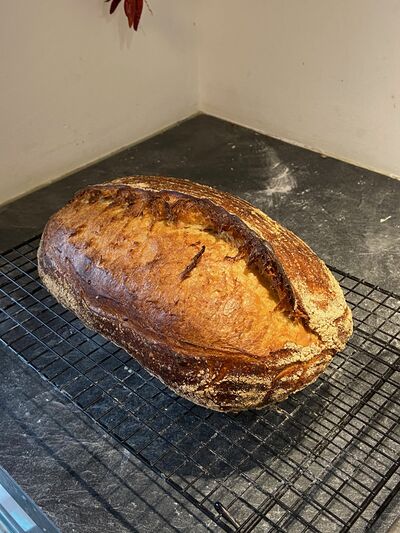Sourdough loaf 2

A recipe that is relatively simple and works. I find it works best over 3 days.
Allow 6½ hours on day 2 from mixing dough to putting away in fridge.
- Day 1 - refresh starter
- Day 2 - make up starter. Once starter is really active (5-6 hours) make dough etc and once in proving basket put in fridge overnight.
- Day 3 - bake
Ingredients
| Ingredient | Overall | Baker's percentage |
Startter | Final dough |
|---|---|---|---|---|
| Bread flour* | 650 g | 90,3% | 70 g | 580 g |
| Whole rye flour | 60 g | 8,3% | 60 g | |
| Water | 520 g | 72,2% | 70 g | 450 g |
| Salt | 12 g | 1,7% | 12 g | |
| Sourdough culture | "scrapings" | 140 g | ||
| Total | 1242 g | 140 g | 1242 g |
* I've used de Zuidmolen stoneground Tarwemeel and de Zuidmolen french type 65, I prefer the former for this loaf
Method
- Starter. The day before. Take the jar with scrapings, i.e. dried crust left in jar, of sourdough culture and add the water and flour. Mix well and leave overnight. The next day you will use the contents of jar and the uncleaned jar will be the basis for the next batch. If the rising of the starter has been sluggish, usually because the starter has not been refreshed recently, you will have to refresh again. To do this, discard starter and in the uncleaned jar add 50g of water and 50g of flour every 12 hours till the starter is healthy and lively again.
- Mix & rest 30 minutes : Add the water flour and salt and mix it together into a dough with your dough scraper. Mix for a minute or so to make sure everything is combined. Let this mixture rest and soak for 30 minutes.
- First Fold & rest 2 hours : Spray the work surface with water, and the top of your dough. Turn the dough out onto the wet surface upside down. Work around the dough pinching a piece with your finger and thumb, stretching it out and folding it back over the dough making a ball. Around 12 folds should be enough. Roll the dough back over, smooth side up, return it to the bowl, spray the top with water, cover with a clean cloth and leave to rest for 2 hours at room temperature.
- Second Fold & rest 2 hours : After the dough has rested it should have puffed up slightly already. Spray the table and dough again with water. Turn the dough out and reshape into a ball. 6 stretches and folds should be enough this time, roll the dough over with the smooth side on top and tuck everything underneath with your hands. Return the dough to the bowl for a further 2 hours.
- Third Fold & rest 60 minutes : After the dough has rested for this second time there should be clear signs of the dough rising, Stretch and fold the dough once more exactly like the last time, and return the dough to the bowl to rest for 1 hour.
- Pre-shape & rest on bench 60 minutes : This time after resting it’s time to pre-shape the dough. Dust your surface with flour, turn out your dough upside down onto the surface. If you have doubled the recipe to make two loaves, divide it into two at this point with the flat side of your dough scraper. Shape the dough into a ball really quite tight without tearing it. Rest on the side for 1 hour covered with a cloth.
- Final Shape & rest in fridge overnight : In the final shaping the aim is to create a tight structure without degassing the dough too much. So be delicate with the folds but still creating tension. Dust your work surface with a little flour, slide your dough scraper underneath and turn the dough upside down onto a lightly dusted surface. Let it relax into a circle. Pick up the side edges one by one, stretching out very slightly and folding over the dough, one over the top of the other. Roll the dough from the top edge towards you into a sausage and stick it onto the sticky patch closest to you, pinching the seam to stick in place. When you are done, dust it well with semolina or a wholemeal flour, and dust an oval banneton basket too. Place the dough in the basket upside down (seam side up). If you don’t have a basket, line a colander or bowl with a cloth and dust it well.
- Final Rest : At this stage rest your dough in the fridge uncovered to prove nice and slowly overnight.
- Bake : If you have a baking stone then use it. Also, put a roasting tin or cast iron pan below the shelf you are baking on. Once loaf is in oven pour boiling water into tray to create a steamy environment in the oven. Bake at 240℃ for 15 minutes and then reduce to 190℃ and bake for a further 20 minutes.
Jack of BakeWithJack https://www.bakewithjack.co.uk/videos/2019/6/6/bread-tip-101-beginners-sourdough-loaf-start-to-finish